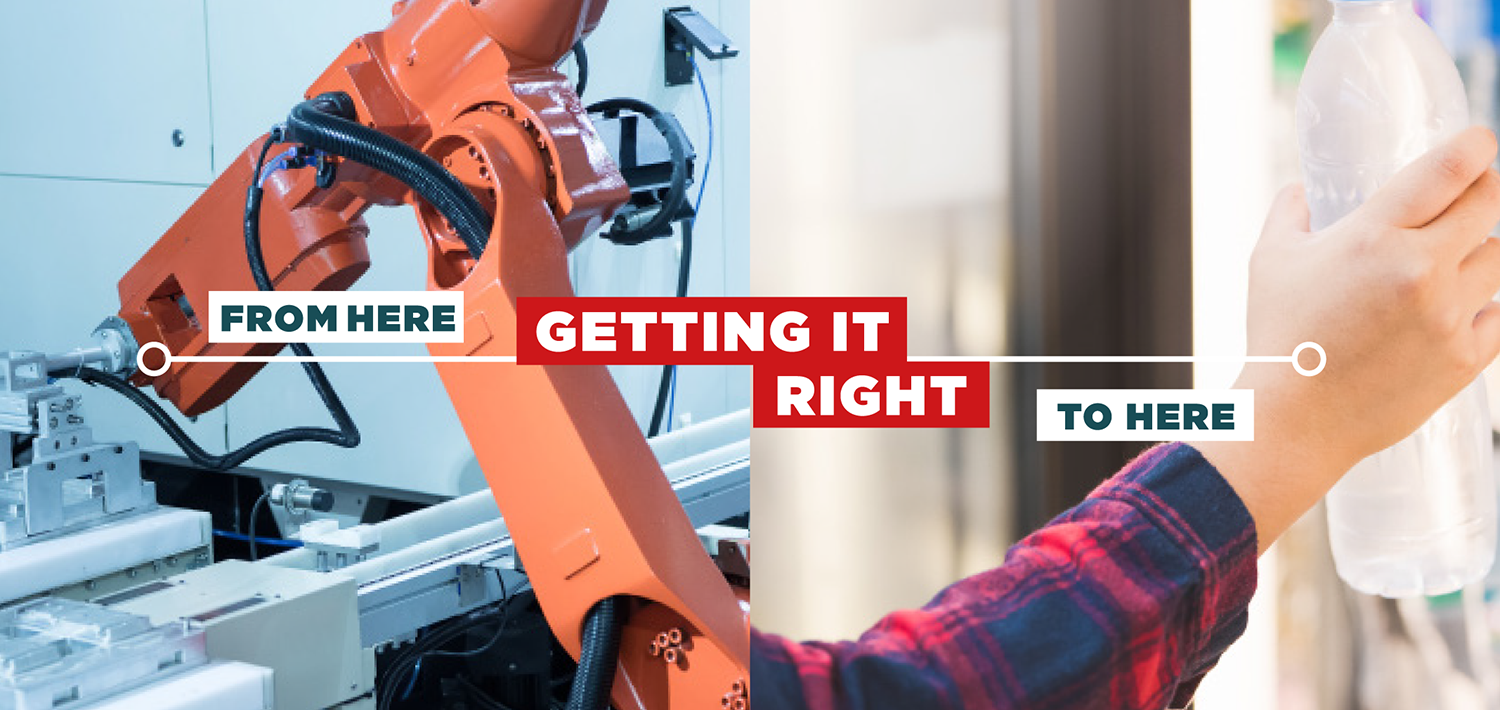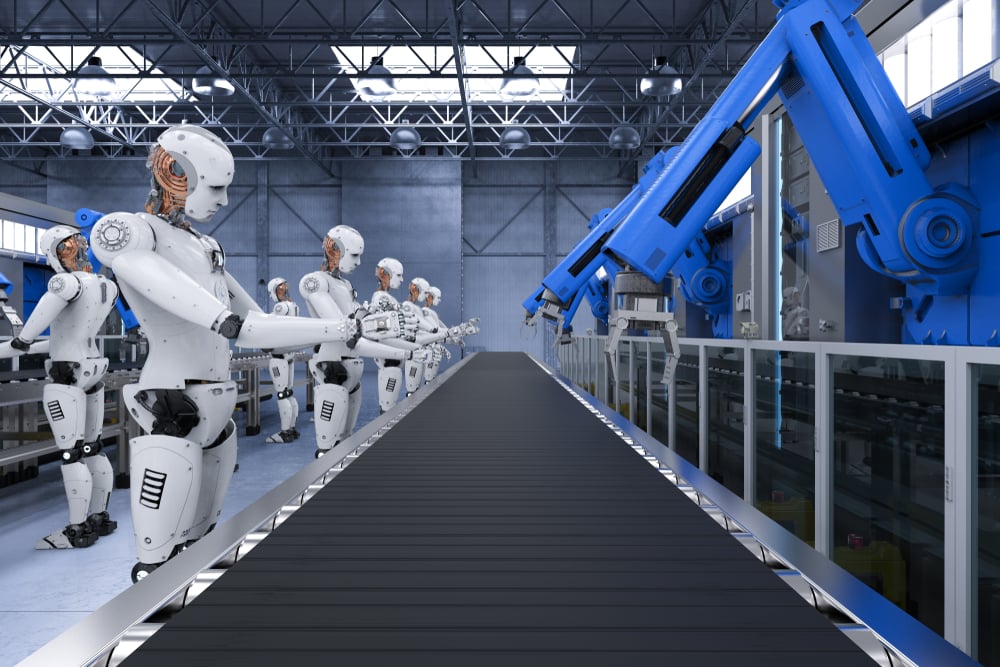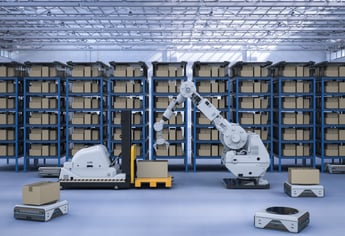Warehousing: Are you Keeping up with Automation?

Picture the typical retail warehouse of 15 years ago: Workers rode around on forktrucks and pallet jacks, picking and putting away product by the pallet load, loading trailers for single stores, or several at a time. It was pretty regular stuff – Store 14 got its load on Thursday – with occasional surges for seasonal or promotional product.
Fast forward to today's retail DC and you'll likely see significant differences fuelled by the rise of e-commerce, omnichannel fulfillment and the growing trend towards buying fresh food online. The imperative now is speed and accuracy in an extremely competitive retail environment.
Failure to meet rapidly rising customer expectations in this context will mean failure. Period.
Thus inside the DC – or fulfillment center as they are more accurately described in e-commerce – the focus has shifted from regular store-bound orders to individual customer orders. The workers are doing completely different work, and are often toiling alongside robots. Even the internal infrastructure is evolving from static racking to massive automated storage and retrieval systems (AS/RS), and goods-to-person setups that are fed by robots.
Automation is everywhere, and everything is moving at light speed. Get it right and you win omnichannel ecommerce. Make a mistake and it's a potential nightmare.
The evolution of retail warehousing
That old-school warehouse described above is no dinosaur. In fact, it's a distribution model that many retailers still use, and have implemented in recently commissioned facilities. But it's not a model that serves omnichannel commerce very well.
Retailers today are being stretched to respond to the demands of combining online orders with brick-and-mortar operations. E-commerce orders are not palletized, or even case-picks, they are composed of eaches, individual items that must be 'shopped' from a DC or store, typically by a human being.
Trying to fulfill store replenishment orders from the same stock that e-commerce orders are picked from is a non-starter. E-commerce orders, in addition to individual item picks, need fast fulfillment, packaging for shipment through parcel post, and delivery to disparate locations. The order of complexity is high and the cost of all those touches can be staggering.
Retailers are exploring numerous potential solutions to these challenges, each of which is contributing to the rapid evolution of distribution and fulfillment models.
Automation, hyper-local fulfillment, buy online, pickup in store (BOPIS), and various combinations of these solutions are proliferating, each with advantages and pitfalls to consider.
Enter automation
Warehouse robotics suppliers cannot keep up with demand for their product these days.[1] Why? A couple factors are playing into the new popularity of warehouse robotics.

First, human labour is problematic. People are expensive, error-prone and hard to find. Low unemployment rates are making warehouse fulfillment jobs harder and harder to fill.[2]
Second, robotics move faster than humans, can operate 24-7, never unionize, and can be deployed and re-deployed flexibly. A system set up for goods-to–person fulfillment using automation plus humans, for example, would need to have an accurate forecast for 10 years out in order to pay off.[3] Robots can also work alongside humans, now, with co-bots (collaborative robots) demonstrating they are fully capable of safely picking from the same totes as a human partner;[4] as well as roaming the fulfillment center floor without running anyone over.
With the speed retail trends are moving, this flexibility is a key competitive advantage for omnichannel retailers.
On the other side of the automation coin are the gigantic, stationary AS/RS units. These have been around for a while, but now they are being constructed as the core of many DCs. The units are many stories tall with hundreds of thousands of storage cells inside, each accessed via a mobile robotic carrier that pulls inventory as its needed and feeds it down to packing stations.
This trend began in Europe where space is limited and labour expensive, and has seen recent uptake in North America, especially in the grocery marketplace, where temperature controlled storage is needed. These 'lights-out' buildings need no humans to operate, which is convenient because finding staff to work in cold storage is even harder than finding regular warehouse workers.
Complete integration
 Robotics and automation at these levels of sophistication require a great deal of coordination. Making the best use of expensive assets like massive self-supporting AS/RS buildings or robotic fulfillment systems means that all the parts of the supply chain feeding into and flowing out of the DC must be carefully orchestrated. When you have a fully automated building, you don't leave the scheduling of inbound loads to a fallible human with a spreadsheet and telephone or email.
Robotics and automation at these levels of sophistication require a great deal of coordination. Making the best use of expensive assets like massive self-supporting AS/RS buildings or robotic fulfillment systems means that all the parts of the supply chain feeding into and flowing out of the DC must be carefully orchestrated. When you have a fully automated building, you don't leave the scheduling of inbound loads to a fallible human with a spreadsheet and telephone or email.
That's where you need a comprehensive, automated scheduling system - such as C3 Reservations - to make sure that trailers arrive at the docks when they need to be there. Likewise, with a large, automated warehouse, it's highly likely that there will be trailers to manage in the yard.
These systems take the guesswork and human error out of scheduling and yard management, integrating seamlessly with the automation that powers the DC. The systems talk to each other, which means your people don't have to spend their time fruitlessly tracking down truck drivers to find out when they plan to arrive, or searching through thousands of trailers in the yard to find the one that's needed now. That's how a relatively small investment in yard management and dock scheduling can help make the most of a big investment in DC technology.
RESOURCES:
[1] "Robot maker reaches production capacity on U.S. orders", Inside Logistics Online Staff, Inside Logistics, November 8, 2018.
[2] "Robots Are Taking Over the E-Commerce Warehouse", Robert J. Bowman, SupplyChainBrain, April 9, 2018.
[3] "Robots Are Taking Over the E-Commerce Warehouse", Robert J. Bowman, SupplyChainBrain, April 9, 2018.
[4] "Universal Robots makes its debut at Modex", Inside Logistics Online Staff, Inside Logistics, April 10, 2018.

